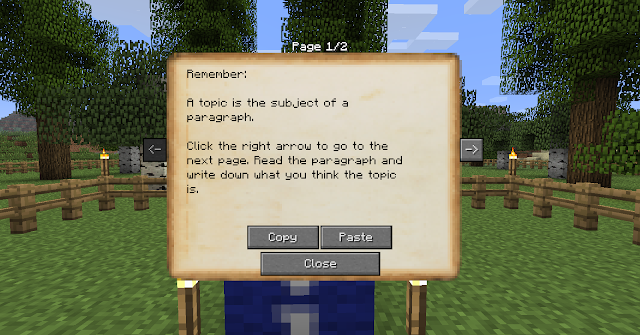How many blog writers eventually say, "it's been a while since my last post, but...." Well, here's mine. After my last post on April 4th the funding for the curriculum came through, and the work began. Since then I've gathered over 500GB of student and teacher FRAPS videos - mostly in-game interactions, as well as live footage of several of my own lectures and student interactions in the classroom. We meet twice a week for one hour and fifteen minutes each time. I am quickly finding out that teaching language alongside of Minecraft is a formidable task, especially given the fact that students were not introduced to the game until halfway through the quarter, thus, increasing the learning curve significantly. Despite this, the project has been moving forward, and student essay show engagement in the game and in the target language. Good stuff there. Without further delay, here's a description of Unit 3.
The writing focus of Unit 3 is the descriptive essay. The topic focus is architecture/interior design. Students begin the unit by working to describe a few pictures using some basic adjectives. Each of the pictures they describe is of the interior of a room. The first reading of the unit is an excerpt from "Roughing It" by Mark Twain. We do some traditional language instruction on adjectives and adjective clauses, and then students are free to explore the Minecraft component of the course. The world they are presented with consists of a random seed with three unique houses built in. The first is a tree house:
Each house has three rooms. Some share rooms, while others are different. The tree house has a kitchen, a theater room, and a bedroom inside. The water house has a kitchen, a bathroom, and a music room:
The last house is a house built into the ground. The students refer to this one as the "cave house."
Each house is fairly extensive. Students are asked to explore each of the three houses, and to take notes in the appropriate pages of their workbooks. I ask them specifically to use at least two adjective clauses in their essay, and also to be as specific as possible about their descriptions, calling on the five senses for additional detail. We also do figurative language in this unit.
At first the students were confused as to the link between the language and the task. They didn't understand why they weren't writing in a writing class. They only got to explore for about 30 minutes during the first class, though, and were much more warmed up during the second class period of unit 3. After two weeks of running language and in-game activities they each submitted a descriptive essay. The prompt has them writing an article for Creative Design Magazine. Overall, I was very pleased by how their writing turned out. I'll try to share some writing samples soon.
The writing focus of Unit 3 is the descriptive essay. The topic focus is architecture/interior design. Students begin the unit by working to describe a few pictures using some basic adjectives. Each of the pictures they describe is of the interior of a room. The first reading of the unit is an excerpt from "Roughing It" by Mark Twain. We do some traditional language instruction on adjectives and adjective clauses, and then students are free to explore the Minecraft component of the course. The world they are presented with consists of a random seed with three unique houses built in. The first is a tree house:
Each house has three rooms. Some share rooms, while others are different. The tree house has a kitchen, a theater room, and a bedroom inside. The water house has a kitchen, a bathroom, and a music room:
The last house is a house built into the ground. The students refer to this one as the "cave house."
Each house is fairly extensive. Students are asked to explore each of the three houses, and to take notes in the appropriate pages of their workbooks. I ask them specifically to use at least two adjective clauses in their essay, and also to be as specific as possible about their descriptions, calling on the five senses for additional detail. We also do figurative language in this unit.
At first the students were confused as to the link between the language and the task. They didn't understand why they weren't writing in a writing class. They only got to explore for about 30 minutes during the first class, though, and were much more warmed up during the second class period of unit 3. After two weeks of running language and in-game activities they each submitted a descriptive essay. The prompt has them writing an article for Creative Design Magazine. Overall, I was very pleased by how their writing turned out. I'll try to share some writing samples soon.





